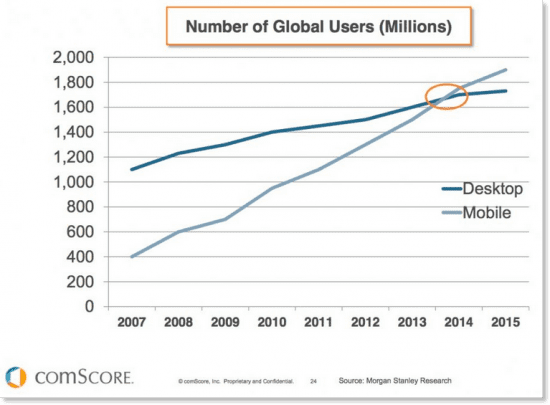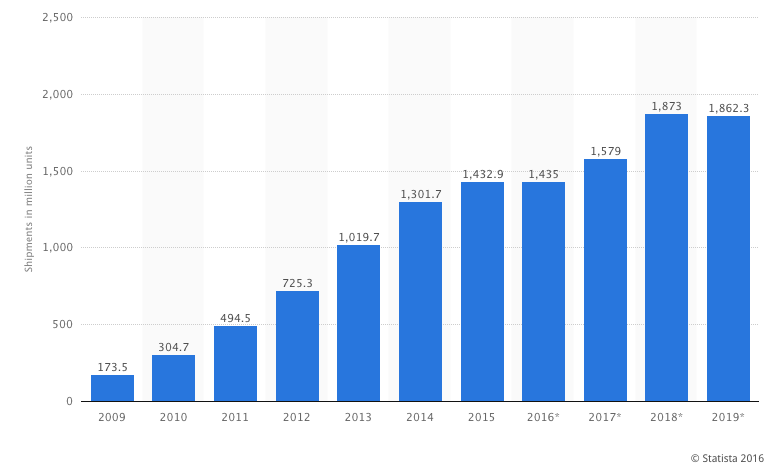Your customers and employees are now in a world where they have never been so connected. Smartphones are everywhere and mobile is now the remote control for the world around us, with the marketing and advertising industry having gone through rapid change. Attention has moved away from traditional media towards more digital forms, meaning this growth has meant firms need to rethink their strategic approach.
The shift from traditional to digital forms of media
According to Connor (2015), marketing agencies were expected to spend $540 billion worldwide on advertising in 2015, led by a 15.7% growth in digital media; with television, newspapers and magazines either on the decline or showing stunted gains, offering further proof that traditional media may be on its way out. This became evident when in 2004, The Economist mentioned traditional forms were no longer delivering due to the diversity of media and the emergence of new technology, notably the internet. This is due to as Joines (2003) suggests, consumers are spending more of their time online. As technology advanced, internet users no longer kept logging in and out of profiles, they are now constantly connected anywhere, anytime, with mobile the key frontrunner.
Why mobile?
The growth and usage and acceptance of mobile is growing notoriously. As the below graph shows, mobile has overtaken desktop for the number of global users.

The increase of mobile vs. desktop is attributed to the smartphone usage souring, as shown in the graph below where shipments of smartphones, according to Statista (2016), are expected to reach over 1.7 billion by 2018, a tenfold increase from the amount of shipments in 2009 meaning by 2017, an estimated 34% of the world’s population will have a smartphone, a figure that was at less than 10 percent in 2011. This upturn in the smartphone is attributed to the growing popularity of several key operating systems, namely Android and iOS.

The affects this is having on advertising and marketing
The increasing smartphone usage means advertisers and marketers need to align their strategies and campaigns to a more mobile-centric direction. For example, Google prioritises mobile-friendly websites in search results. This shows how many service organisations are making sure they are meeting the changing needs of their consumers, meaning firms need to make sure their site is mobile-friendly to increase their brand awareness on mobile.
Smartphones have become large sources of data where advertisers and marketers can target promotions at individuals due to the data they transmit. Location tracking is key for targeted marketing. There is concerns with this as mobile phone users treat location as a privacy concern (Limpf and Voorveld, 2015). In 2012, 19% of mobile phone owners turned off the location tracking feature because they were concerned that other individuals or companies could access that information. That figure rises among smartphone owners, 30% of whom have turned off location tracking (CMO Council, 2015). Smartphones also provide masses of information on preferences and tastes, meaning advertisers and marketers have the ability to be much more specific in their advertisements and marketing campaigns, offering a more relevant and targeted message to the user, making mobile the ultimate medium for one-to-one marketing as Tsang, et al, (2014) suggests.
This trend has led to consumers expecting this increased targeted brand advertising, using their phone to consult them in everyday decisions, with 73% of people always having their mobile device with them (Facebook research, 2015). Speed and relevance of advertisement has become essential, and to make an influence on the decision-making process of the consumer, advertising needs to increase value according to Haghirian, et al, (2005). If this value is not added, it can result in a consumer consuming another brand.
To read more affects this has had on advertising and marketing, click here.
It is not all thrills
Chaffey (2015) states that data shows that smartphone add-to-cart and conversion rates are much lower than those for desktop, showing the impact of mobile on advertising and marketing depends on the type of industry the organisation operates within. For example, this statement is important if you’re making the business case for a mobile-responsive site, as budget may be better spent on other areas that add more value.
Biswas and Mousumi (2014) back Chaffey up by stating the experience of shopping at an online retailer varies according to perceived ease-of-use and information quality. In some cases, the experience of shopping at a particular online retailer through a mobile phone is so negative that consumers prefer to make purchasing decisions at physical retail outlets.
The lack of standardisation in mobile device technologies is a problem, as they vary in screen sizes, operating systems and browsers. This makes mobile phone marketing a nightmare as material has to be compatible with that device.
With the technological advancements and the increased use of apps, retailers have to tackle ‘showrooming‘ where consumers visit a physical store to research products, but use their smartphone in-store for price-comparison, often resulting in them buying it online (Fulgoni, 2013), affecting the revenue of physical stores.
Click here to see more challenges mobile phone marketing faces.
How should mobile marketing be approached?
According to Chaffey (2015), the implications are clear – if you’re not able to reach your audience through mobile search or display, or you’re not providing a satisfactory mobile experience, you will miss out compared to your competitors who are. As Cohen (2016) suggests, this shows advertisers and marketers need to be present on mobile so customers can find you when and where they’re ready to engage with you. This can be done through mobile websites (65%) and mobile apps (65%), which top the B2B mobile marketing tactics, as shown below by the study conducted by Regalix on the ‘state of B2b mobile marketing, 2015‘. This tactic is backed up by Perez (2014) who states the majority of digital media consumption now takes place in mobile apps, according to a new study in the US released by comScore. This means mobile apps consume more of our time than desktop usage, accounting for 52% of the time spent using digital media. Combined with mobile web, mobile usage as a whole accounts for 60% of time spent, which is staggering and a great opportunity for marketers.

Overall, smartphone usage will continue to grow as shown above, but understanding how and when consumers are using them is crucial for advertising and marketing campaigns, especially as apps are driving the majority of media consumption activity, and mobile has altered, according to Fulgoni (2013), the manner in which consumers make buying decisions and how they complete transactions. This allows marketers to ‘push‘ information to consumers with relevant geographically-targeted messages; or they can deliver ads when the consumer accesses a mobile website. As smartphone data collection and analysis technology becomes more sophisticated, the speed and relevance of advertising and marketing campaigns will be significantly more important; as Vatanparast and Asil (2007) investigate, advertising activities supported by mobile devices allows companies to directly communicate with consumers without location or time barriers. If competing brands reach consumers with a relevant message at the precise moment when it is needed, they will have made that crucial first impression, meaning your brand, along with many others will will be trying to play catch up.
The Internet has moulded who we are as consumers, increasing the accessibility of information with digital becoming a top priority for marketers, while traditional channels lag. At the same time, traditional media still remains an important part in our lives, allowing us to watch what we want, when we want. For marketers and advertisers, it’s important that a balance between both can be found.
See the latest digital marketing trends to watch for in 2016 and beyond
To read more, you may find the following articles interesting:
Smartphone Revolution: There’s An ETF For That
In Less Than Two Years, a Smartphone Could Be Your Only Computer
Why are phones continuing to get bigger?
2016 Mobile Marketing Trends Every Marketer Needs
References
Biswas, A., and Mousumi R. (2014) Impact of Social Medium on Green Choice Behaviour. Journal of Marketing Management 2.2. p95-111. Print.
Chaffey, D. (2016) Mobile Marketing Statistics compilation [Online] Available at: http://www.smartinsights.com/mobile-marketing/mobile-marketing-analytics/mobile-marketing-statistics/ [Accessed: 20 Apr. 16]
Cohen, H. (2016) 2016 Mobile Marketing Trends Every Marketer Needs [Online] Available at: http://heidicohen.com/2016-mobile-marketing-trends/ [Accessed: 20 Apr. 16]
Connor, J. (2015) Global smartphone shipments forecast from 2010 to 2019. [Online] Available at: http://www.huffingtonpost.com/2015/03/24/digital-advertising-climb-tradional-media-trouble_n_6930958.html [Accessed: 20 Apr. 16]
Facebook Research. (2015) The thumb is in charge [Online] Available at: http://insights.fb.com/2015/10/26/the-thumb-is-in-charge/ [Accessed: 20 Apr. 16]
Fulgoni, G. (2013) The Top Ten Burning Issues in Digital [Online] Available at: https://www.comscore.com/Insights/Blog/The-Top-Ten-Burning-Issues-in-Digital#growthofsmartphonesandtablets [Accessed: 20 Apr. 16]
Haghirian, et al, (2005) Increasing Advertising Value of Mobile Marketing – An Empirical Study of Antecedents. Journal of System Science.
Joines, J., Scherer, C., Scheufele, D. (2003) Exploring motivations for consumer Web use and their implications for e‐commerce, Journal of Consumer Marketing, Vol. 20 Iss: 2, pp.90 – 108
Limpf, N. and Voorveld, H. (2015) Mobile Location-Based Advertising: How Information Privacy Concerns Influence Consumers’ Attitude And Acceptance. Journal of Interactive Advertising 15.2. pp 111-123.
Perez, S. (2014) Majority Of Digital Media Consumption Now Takes Place In Mobile Apps [Online] Available at: http://techcrunch.com/2014/08/21/majority-of-digital-media-consumption-now-takes-place-in-mobile-apps/ [Accessed: 20 Apr. 16]
Statista. (2016) Digital advertising expected to climb, while traditional media may be in trouble. [Online] Available at: http://www.statista.com/statistics/263441/global-smartphone-shipments-forecast/ [Accessed: 20 Apr. 16]
Tsang, M., et al. (2014) Consumer Attitudes Toward Mobile Advertising: An Empirical Study. International Journal of Electronic Commerce. p65-78
Vatanparast, R. and Asil, M. (2007) Factors affecting the use of mobile advertising. International Journal of Mobile Marketing. 2, 2, 21-34, Dec.